Believe it or not, i enjoy sound art pieces more than many visual art ones. The reason why i hardly ever write about sound art is because i find it particularly challenging to write half intelligently about sound works. And in most cases, i cannot even rely on spectacular images to hide the shortcomings of my prose. The second confession i need to make is that i don’t care for music. At all. I don’t notice its existence, nor its absence. Yet, i love sound art.
The LABoral art center invited me last week to the opening of a sound art exhibition and luckily for me, this one came with a strong emphasis on the visual presence of sound.
Visualizing Sound – Representations of Sound in Contemporary Creation stems directly from the LEV (Laboratorio de electrónica visual – Visual Electronics Lab) Festival. Launched at LABoral in 2007, the festival focuses on the convergence of electronic sound creation and visual arts.
Visualizar el sonido [Visualizing Sound] brings the same line of enquiry into the white walls of the art center. The result is an exhibition where sound and image perfectly balance each other. Some works give a graphic, architectural and physical presence to sound, others reveal the sound produced by physical objects we’d otherwise regard as perfectly mute.
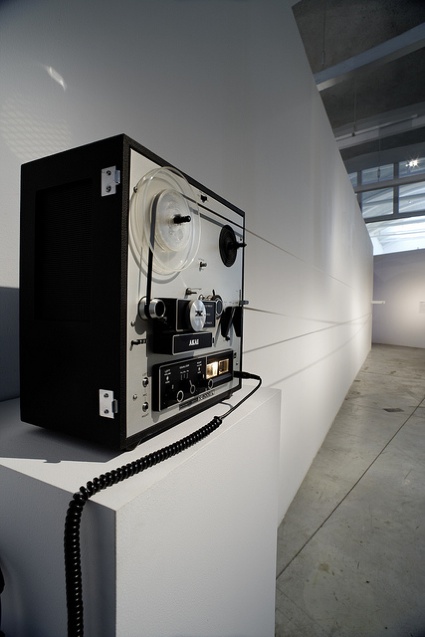 Lucía Rivero, Soundtrack for someone who has been turned round having the bearing of one who’s going away, 2011. Photo Marcos Morilla
Lucía Rivero, Soundtrack for someone who has been turned round having the bearing of one who’s going away, 2011. Photo Marcos Morilla
I realize that Gijón is not the best connected city on this planet but there aren’t many sound art exhibitions as accessible and relentlessly satisfying as this one. So if you happen to be in the area in the coming month (or fancy a luxurious easyjet trip from Stansted or Geneva airport), don’t miss this show.
Here’s some of the works you will see/hear:
Versus is a dialogue between two origami-shaped sculptures placed face to face.
At regular intervals, one of the sculptures produces sounds. Meanwhile, the other machine listens, records and analyzes the sounds. It also moves according to the frequencies of the sounds. Immediately after that, the second sculpture plays back the recorded sound, but it adds to it any disruption caused by the reverberating space and the voices and sounds made by visitors entering the space.
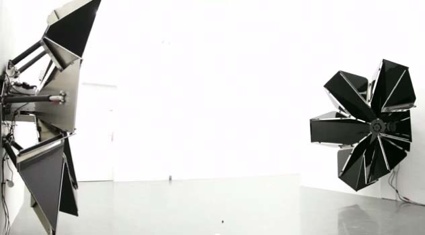
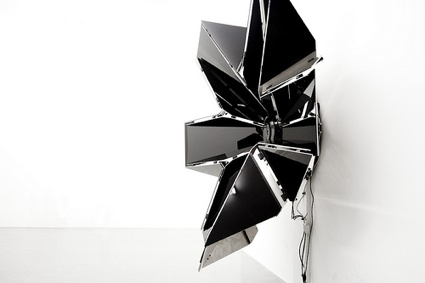 David Letellier, Versus, 2011
David Letellier, Versus, 2011
Visitors are intruders in this conversation, their every noise and presence degrades the communication. Over time, the original sound gets more complex and unpredictable. The memory of past events is on hold for a moment, until it is reproduced, degraded, and then forgotten, replaced by the present.
The video 20 Hz shows a geomagnetic storm occurring in the Earth’s upper atmosphere. This kind of temporary disturbances of the Earth’s magnetosphere are caused by a solar wind shock wave and/or cloud of magnetic field which interacts with the Earth’s magnetic field. That might sound like a far-away phenomenon but these storms do affect our bodies, communication systems and energy structures.
Semiconductor worked with the data collected from CARISMA (the Canadian Array for Realtime Investigations of Magnetic Activity) and translated the space weather phenomenon into image and sound. We hear tweeting and rumble caused by incoming solar wind, captured at the frequency of 20 Hertz. Generated directly by the sound, tangible and sculptural forms emerge suggestive of scientific visualizations. As different frequencies interact both visually and aurally, complex patterns emerge to create interference phenomena that probe the limits of our perception.
The Creators Project has a stunning video interview with Joe Gerhardt and Ruth Jarman of Semiconductor.
Waves is perhaps the work that best sums up the concept of the exhibition Visualizing Sound. A long stretch of rope is hold tightly between two poles. Left to its own devices, the rope remains immobile and soundless. But as soon as visitors approaches, the rope starts spinning, hissing and adopting sinusoid and times, almost menacing volumes.
The installation physically represents a series of waves in space while generating sound by the very physics of motion. By cutting through the air, the rope at once creates volume and produces sound, configuring a single element.
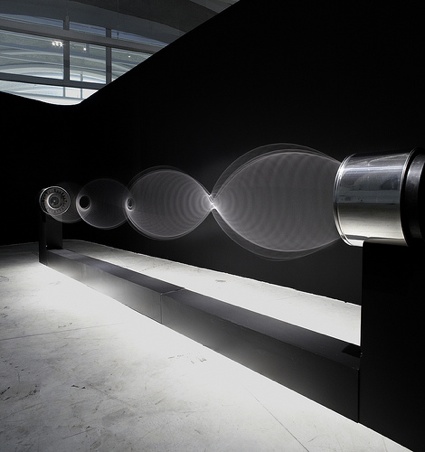 Daniel Palacios, Waves, 2006. Photo Marcos Morilla
Daniel Palacios, Waves, 2006. Photo Marcos Morilla
Table d’harmonie would be compelling enough as a silent installation. It’s graphic, puzzling and it evokes drawings as much as natural or post-industrial landscapes.
The small crates are made of black corundum dust and a loudspeaker is laid out in the center of each. The sound piece is composed with the help of a software programme of granular synthesis, a method by which sounds are broken into tiny grains which are then redistributed and reorganised to form other sounds.
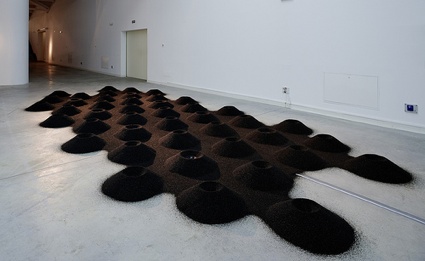 Pascal Broccolichi, Table d’harmonie, 2010. Photo Marcos Morilla
Pascal Broccolichi, Table d’harmonie, 2010. Photo Marcos Morilla
A couple more for the road:
Ryoichi Kurokawa’s rheo: 5 horizons has the whole church at Laboral Ciudad de la Cultura to himself. The audiovisual compositions are so jaw-dropping that showing any work in its vicinity would have been cruel.
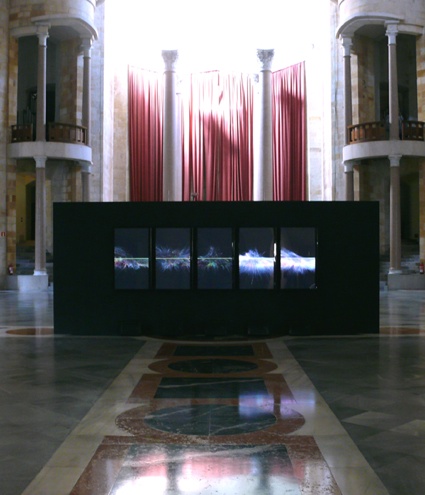 Ryoichi Kurokawa, rheo: 5 horizons, 2010. Image by Nacho Martínez-Useros for tenmagblog
Ryoichi Kurokawa, rheo: 5 horizons, 2010. Image by Nacho Martínez-Useros for tenmagblog
Cylinder literally sculpts music and other sound samples.
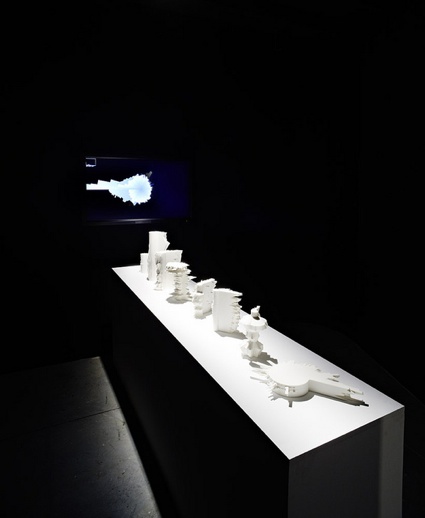 FABRICA , Andy Huntington, Cylinder, 2004. Photo Marcos Morilla
FABRICA , Andy Huntington, Cylinder, 2004. Photo Marcos Morilla
Visualizing Sound – Representations of Sound in Contemporary Creation is curated by Cristina de Silva Marbán & Nacho de la Vega from Fiumfoto. The exhibition remains open at LABoral Centro de Arte y Creación Industrial in Gijón until 25 June 2012.
The 6th edition of L.E.V. Festival at La Ciudad de la Cultura, in Gijón, Spain.
Also on view in LABoral: Experimental Station.
